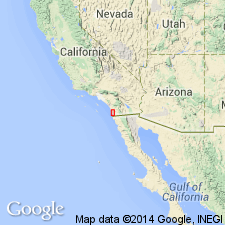
- Usage in publication:
-
- Cabrillo Formation*
- Modifications:
-
- Named
- Biostratigraphic dating
- Dominant lithology:
-
- Sandstone
- Conglomerate
- AAPG geologic province:
-
- Peninsular Ranges province
Summary:
Named as upper of three formations of Rosario Group. Type section designated as exposures at southern tip of Point Loma Peninsula near Cabrillo National Monument, on sea cliffs 250 m east of new Point Loma Lighthouse, where base is 30 m above mean sea level and top is at top of cliff 32 deg 39'55"N, 117 deg 14'45"W, Point Loma quad, San Diego Co, CA. Basal third composed of massive medium-grained sandstone with thin siltstone beds at top and near bottom. Middle third is made up of massive cross-bedded cobble conglomerate containing fresh quartz diorite clasts. Top part consists of medium-grained sandstone, with a lens of conglomerate 2 m thick above middle. Thickness is 81 m at type, ranges up to 171 m. Conformably overlies Point Loma Formation (new). Unconformably underlies unnamed Eocene rocks and Pleistocene deposits. Age is Late Cretaceous (Maestrichtian) based on biostratigraphic dating of foraminifers.
Source: GNU records (USGS DDS-6; Menlo GNULEX).
For more information, please contact Nancy Stamm, Geologic Names Committee Secretary.
Asterisk (*) indicates published by U.S. Geological Survey authors.
"No current usage" (†) implies that a name has been abandoned or has fallen into disuse. Former usage and, if known, replacement name given in parentheses ( ).
Slash (/) indicates name conflicts with nomenclatural guidelines (CSN, 1933; ACSN, 1961, 1970; NACSN, 1983, 2005, 2021). May be explained within brackets ([ ]).

